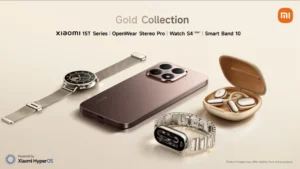Pixel 10 vs Xiaomi 15: Which 2025 Flagship Reigns Supreme?
Google Pixel 10 vs. Xiaomi 15: Who’s the King of Smartphones in 2025?
Hey tech fans, and welcome back to Xiaomiforall.com! Today, we’re diving headfirst into an epic showdown between two titans of the 2025 smartphone scene: the Google Pixel 10 and the Xiaomi 15. Both of these beasts have landed, ready to conquer the market with cutting-edge specs, killer cameras, and a user experience focus that really makes them pop. But, which of these giants deserves your attention (and your hard-earned cash)? Get ready for a deep dive, packed with a little humor and a style that’ll keep you hooked right to the end. We’re going to break down their features, compare them tooth and nail, and help you figure out which one is the best fit for you. Spoiler alert: it’s not going to be an easy choice!
Introduction: Two Philosophies, One Goal
The Google Pixel 10, announced on August 20th, 2025, and hitting shelves on the 28th of the same month, is Google’s crown jewel. It’s famous for its pure Android experience and its AI-powered photography prowess. Then you’ve got the Xiaomi 15, unveiled globally at MWC 2025. This one packs serious hardware muscle, the distinctive Leica touch on its cameras, and the versatile HyperOS system. Both devices are firmly in the premium segment, but their approaches are definitely different. Google’s betting on simplicity and smarts, while Xiaomi’s going all-in on raw power and customization. Ready to see who takes the crown in this battle? Let’s get ready to rumble!
Design: Style Meets Smarts
Google Pixel 10: Sleek Minimalism
The Pixel 10 sticks to the iconic Pixel design language, complete with its signature horizontal camera bar and rounded edges. Measuring 152.8 x 72 x 8.6 mm and weighing in at 204 g, it’s a tad thicker and heavier than its predecessor, the Pixel 9. But, this bulk comes with a cool new feature: Qi2 wireless charging support with integrated magnets, kind of like Apple’s MagSafe. Plus, it throws in the handy Pixelsnap accessories (magnetic charger, ring stand, and more). The build is a solid combo of aluminum and Corning Gorilla Glass Victus 2, boasting IP68 water and dust resistance. Available in sophisticated shades like Jade, Obsidian, and Porcelain, the Pixel 10 is all about functional elegance without being too flashy.
Xiaomi 15: Bold Sophistication
The Xiaomi 15 definitely doesn’t play it safe in the design department. With dimensions of 152.3 x 71.5 x 8.1 mm and a weight of 192 g, it feels lighter and slimmer in your hand, making it super comfortable to hold. Its premium construction features an aluminum frame and a back made of glass or vegan leather (depending on the edition), all with IP68 resistance. The Leica collaboration really shines through in the distinctive circular camera module. Bold color options like Green, Black, and White make it stand out, and its subtly curved display adds a modern flair. Plus, they’ve thrown in an optional Photography Kit with a grip, shutter button, and 67mm filters – perfect for the shutterbugs out there.
Design Verdict: If you’re all about that clean, functional look, the Pixel 10 is your jam. But if you dig a more daring, premium aesthetic and love to accessorize, the Xiaomi 15 takes the lead.
Display: A Window to the Future
Google Pixel 10: Fluidity and Balance
The Pixel 10 sports a 6.3-inch OLED display with FHD+ (1280 x 2856) resolution and a smooth 120 Hz refresh rate. It hits a peak brightness of 2,000 nits and supports HDR10+, delivering vibrant colors and exceptional contrast – perfect for binge-watching or gaming marathons. The Gorilla Glass Victus 2 protection ensures it can handle daily wear and tear, and its flat design is a win for anyone not keen on curved screens.
Xiaomi 15: Dazzling Brightness
The Xiaomi 15 cranks things up a notch with a 6.36-inch AMOLED display, a sharper 1.5K (1440 x 3200) resolution, and also a buttery-smooth 120 Hz refresh rate. Its peak brightness blasts up to 3,200 nits, totally outshining the Pixel 10 and making it a champ for outdoor visibility. It also supports HDR10+ and Dolby Vision, which really elevate the multimedia experience. That slight curve on the display adds a premium feel, though it might be a magnet for accidental touches for some.
Display Verdict: The Xiaomi 15 is the winner if you crave higher resolution and serious brightness, making it ideal for an immersive visual feast. The Pixel 10, however, offers a more practical and efficient display for everyday use.
Performance: Power vs. Intelligence
Google Pixel 10: AI Takes the Wheel
The Pixel 10 debuts the Tensor G5 chip (a 3nm marvel built by TSMC), which is laser-focused on optimizing AI tasks like photo processing, real-time translation, and the Pixel Sense assistant. Paired with 12 GB of LPDDR5X RAM and storage options from 128 GB to 256 GB, it’s more than capable for everyday tasks. While it might not top AnTuTu benchmarks (around 1,000,000 points), its strength lies in efficiency and a super-smooth user experience, not just raw brute force.
Xiaomi 15: A Rocket in Your Pocket
The Xiaomi 15, on the other hand, boasts the Snapdragon 8 Elite (also 3nm), one of the most potent chips of 2025. It shatters benchmarks with an AnTuTu score exceeding 1,148,512 points. With 12 GB to 16 GB of LPDDR5X RAM and storage options ranging from 128 GB all the way up to 1 TB, this phone is built to absolutely crush demanding games, heavy multitasking, and all your most power-hungry apps. HyperOS 2.0, built on Android 15, adds a layer of personalization and fluidity, although some might find it a tad cluttered.
Performance Verdict: The Xiaomi 15 is the undisputed champ when it comes to raw power, making it the go-to for gamers and power users. The Pixel 10 truly shines in AI-driven tasks and optimization, perfect for those who value smarts over sheer muscle.
Cameras: The Battle for the Best Shot
Google Pixel 10: Computational Magic
The Pixel 10 marks a significant upgrade with its triple camera system, a first for the base model:
* Main: A hefty 48 MP sensor with an f/1.7 aperture, featuring an improved sensor for stellar low-light performance.
* Ultra-wide: 13 MP, f/2.2.
* Telephoto: 10.8 MP, f/2.2, offering a clean 3x optical zoom.
But Google’s real magic is in its software. The AI processing, with features like Video Boost, Magic Eraser, and enhanced night modes, ensures your shots are consistently crisp and vibrant. The 42 MP front-facing camera is fantastic for high-quality selfies, and the 8K video recording is a nice bonus for content creators.

Xiaomi 15: Leica to the Rescue
The Xiaomi 15, leveraging its partnership with Leica, presents an equally impressive triple-camera setup:
* Main: A massive 50 MP sensor with an f/1.6 aperture and a 1-inch sensor size for incredible light-gathering capabilities.
* Ultra-wide: Another 50 MP shooter with an f/2.2 aperture.
* Telephoto: A 50 MP sensor with an f/2.0 aperture, providing a 3.2x optical zoom.
Leica’s tuning delivers natural color tones and gorgeous bokeh, especially in portrait shots. The 32 MP front camera is solid, and it also supports 8K video. The optional Photography Kit really elevates the whole shooting experience to near-professional levels.

Camera Verdict: The Pixel 10 leads in software and versatility across various conditions, while the Xiaomi 15 excels in hardware and low-light prowess. If you’re an aspiring photographer, the Xiaomi 15 might just be your pick; if you want consistently great results without the fuss, the Pixel 10 is tough to beat.
Battery Life: Who Lasts Longer?
Google Pixel 10: Steady Power
The Pixel 10 packs a 4,970 mAh battery, supporting 27W fast wired charging and 25W Qi2 wireless charging. In our tests, it comfortably lasts a full day with moderate usage, but it doesn’t exactly blow the competition away. The Tensor G5’s efficiency helps optimize power consumption, but the charging speeds aren’t the fastest out there.
Xiaomi 15: Blazing Fast Charging
The Xiaomi 15 comes equipped with a beefy 5,410 mAh battery and a mind-blowing 90W fast charging, capable of refilling the battery in under 30 minutes. It also supports 50W wireless charging and reverse wireless charging. In tests, it consistently outperforms the Pixel 10 in battery endurance, especially during intensive tasks like gaming or streaming.

Battery Verdict: The Xiaomi 15 clearly wins here with its larger capacity and ridiculously fast charging. It’s perfect for users who need a phone that can keep up all day and refuel in the blink of an eye.
Software: Pure vs. Polished
Google Pixel 10: Android as It Should Be
The Pixel 10 runs pure Android 16, offering a clean, intuitive interface and a stellar 7 years of guaranteed updates (all the way until 2032!). Features like Pixel Sense, seamless Gemini integration, and AI tools for real-time translation and advanced photo editing make it a dream for those who love simplicity and long-term support.
Xiaomi 15: HyperOS Powerhouse
The Xiaomi 15 utilizes HyperOS 2.0, built on Android 15. It offers a highly customizable interface that’s visually rich but definitely more loaded than stock Android. You get 4 years of OS updates and 6 years of security patches, which is solid, but it doesn’t quite match the Pixel’s longevity. HyperOS includes neat features like dynamic desktops and multitasking optimizations, but it might feel a bit overwhelming for users who prefer a more minimalist approach.

Software Verdict: The Pixel 10 takes the win for its pristine user experience and extended software support. The Xiaomi 15 is fantastic for those who love to tweak and personalize every single aspect of their smartphone.
Price Point: Is It Worth the Splurge?
- Google Pixel 10: Starts at around $799 (roughly ₹80,000), a competitive price for a flagship offering extended updates and a top-tier camera experience.
- Xiaomi 15: Kicks off at $800-$900 (prices vary by region), slightly pricier in some configurations, but its superior hardware specs arguably justify the cost.
Price Verdict: The Pixel 10 offers better long-term value thanks to its update policy, while the Xiaomi 15 justifies its price tag with its premium, bleeding-edge specifications.
Head-to-Head Table: Google Pixel 10 vs. Xiaomi 15
| Feature | Google Pixel 10 | Xiaomi 15 |
|---|---|---|
| Launch Date | August 28, 2025 | MWC 2025 (Feb/Mar) |
| Display | 6.3” OLED, FHD+, 120 Hz, 2,000 nits | 6.36” AMOLED, 1.5K, 120 Hz, 3,200 nits |
| Processor | Tensor G5 (3 nm) | Snapdragon 8 Elite (3 nm) |
| RAM/Storage | 12 GB / 128-256 GB | 12-16 GB / 128 GB-1 TB |
| Rear Cameras | 48 MP (main) + 13 MP (UWA) + 10.8 MP (3x) | 50 MP (main) + 50 MP (UWA) + 50 MP (3.2x) |
| Front Camera | 42 MP | 32 MP |
| Battery | 4,970 mAh, 27W wired, 25W wireless | 5,410 mAh, 90W wired, 50W wireless |
| OS | Android 16, 7 years of updates | HyperOS 2.0 (Android 15), 4 years OS updates |
| Weight | 204 g | 192 g |
| Starting Price | ~$799 | ~$800-900 |
The Final Verdict: Which One Should You Grab?
The showdown between the Google Pixel 10 and the Xiaomi 15 is incredibly close, and your final choice really boils down to what matters most to you. If you’re craving a pure Android experience, long-term software updates, and a camera that shines thanks to its clever software, the Pixel 10 is probably your best bet. It’s perfect for folks who value simplicity and deep AI integration in their daily lives. On the flip side, if you’re after top-tier hardware, blazing-fast charging, and a premium photography experience powered by Leica, the Xiaomi 15 is hard to beat, especially for gamers and content creators.

Here at Xiaomiforall.com, we can’t help but have a soft spot for the Xiaomi 15 due to its sheer power and versatility. But let’s be honest, the Pixel 10 is a seriously formidable contender! Which one is calling your name? Let us know your thoughts in the comments below, and give this article a share if it helped you make up your mind! Are you Team Pixel or Team Xiaomi? The decision is all yours!






